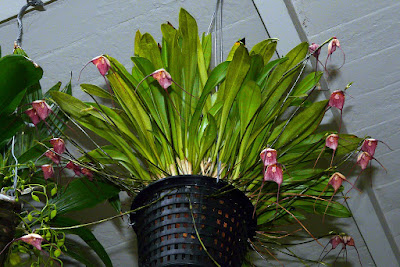Dracula erythrochaete is native to Costa Rica and Panama. In Costa Rica, these plants were found in the province of Alajuela near Candelaria at an altitude of 2000 m...
Dracula erythrochaete also called as The Red-Tufted Dracula, Dracula burbidgeana, Dracula erythrochaete var gaskelliana, Dracula gaskelliana, Masdevallia astute, Masdevallia burbidgeana, Masdevallia erythrochaete, Masdevallia erythrochaete var. gaskelliana, Masdevallia gaskelliana, is a species of the genus Dracula. This species was described by Luer in 1978.
IDENTIFY DRACULA ERYTHROCHAETE
Dracula erythrochaete is native to Costa Rica and Panama. In Costa Rica, these plants were found in the province of Alajuela near Candelaria at an altitude of 2000 m, and between San Ramón and Balsa at an altitude of 1100 m. They were also found in the province of Cartago near Río Macho at 1500 m, and the province of San José in the mountain rainforest near Cristobal on 1800 m in height. In Panama, they were found at heights of 1700-2100 m in the province of Chiriquí, in the north of Boquete and in the dwarf forests of Cerro Hornito. They were also found in the Cardinaliers de Talamanca in the province of Boca del Toro.
It is a small sized, cool growing epiphytic plant, which reaching 27 cm in height, with a short creeping rhizome and short, erect, 2-4 cm long ramicauls carrying a single, apical, erect, coriaceous, oblanceolate or linear-lanceolate, tridenticulate at the obtuse apex, 8-23 cm long, bright green leaves that are close together on the rhizome.
The Red-Tufted Dracula blooms in spring and summer on thin pendulous, 15-25 cm long, slender, terete, basally sheathed, successively single flowered inflorescence with ovate bracts carrying non-fragrant, apical flowers that slowly open one at a time. The flowers are very variable in color. The outer whorls are white or pale yellow and have rare or densely arranged purple or brown spots. Below the center are often stained red, purple or brown, and the inner surface is quite densely covered with short hairs. The tips of these petals lengthen to form long, slender, dark red tails. The inner coat flakes are white or ivory and purple or brown in color. The white lip is often colored in pink or light brown and the rod is yellowish-white.
DRACULA ERYTHROCHAETE CARE AND CULTURE
Cultural information should only be used as a guide, and should be to be adapted to suit you. Your physical location; where you grow your plants, how much time you have to devote to their care, and many other factors, will need to be taken into account. Only then can you decide on the cultural methods that best suit you and your plants.
Light:
Dracula erythrochaete needs a light level of 12000-18000 lux. The plants should grow in the shade, the light should be filtered and dispersed, and the plants should never be exposed to direct sunlight. Strong air movement should be ensured all the time. If the plants do not flower, the amount of light should be gradually increased, taking care not to burn the leaves.
Temperature:
It is a plant with moderate to cold thermal requirements. In summer, the average day temperature is 22-23 ° C, at night 13 ° C, with a daily amplitude of 9-10 ° C. The average winter temperature is 21 ° C at night, 11 ° C at night, with a daily amplitude of 10 ° C.
Humidity:
The Red-Tufted Dracula need about the humidity of 80-85% for most of the year, but in winter and early spring it drops to around 70%.
Substrate, growing media and repotting:
Dracula erythrochaete must be mounted or planted into hanging baskets or mesh pots. These plants are also usually grown in hanging baskets lined with moss sphagnum and filled with a loose, quickly drying substrate containing cut sphagnum moss or perlite to retain moisture and charcoal, which prevents souring the substrate and relaxes it.
It is recommended to repot annually. Some breeders recommend using only loosely packed sphagnum moss from New Zealand, but using this material repotting should be done every 9-12 months, especially when high-mineralized water is used for watering. When the moss begins to decompose, the balance of trace minerals is dramatically disturbed which can lead to plant damage. Regardless of the substrate used, the plants must be repotted when the substrate begins to degrade or when the plants grow out of the container. Repotting should be carried out when new roots begin to grow, because then the plant will stabilize in the shortest possible time. This is usually done at the end of winter or early spring, but it can be done at any time, if it does not interfere with flowering.
Watering:
During active growth, from late spring to autumn, Dracula erythrochaete should be watered frequently, but at the end of autumn, watering should be gradually reduced. However, these plants should never be dried.
Fertilizer:
During the active growth, the plants should be fertilized every week 1/4-1/2 of the recommended dose of fertilizer for orchids. From spring to mid-summer, you can use fertilizer enriched with nitrogen, then switching to phosphorus-enriched fertilizer in late summer and autumn.
Rest period:
In winter, watering should be limited, but Dracula erythrochaete must never be allowed to dry up completely. Fertilization should be limited until spring, when stronger watering resumes.















COMMENTS